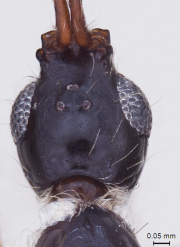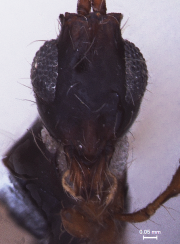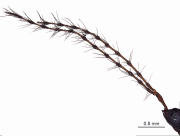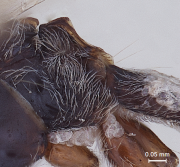 Fig 1. Body, dorsal view |
 Fig 2. Profile (female) |
 Fig 3. Profile (male) |
 Fig 4. Head, dorsal view |
 Fig 5. Head, front view |
|
 Fig 6. Antenna (female) |
 Fig 7. Antenna (male) |
 Fig 8. Forewing |
 Fig 9. Mesosoma, dorsal view |
 Fig 10. Metapleura and propodeum |
 Fig 11. Distribution map |
|
Nomenclature
Alareka Rajmohana & Narendran. 2000: 21-28. Type species Alareka keralensis Rajmohana and Narendran, 2000.
Diagnosis
About 2.5mm long, delicate forms. Head and body pale yellowish brown to black, with appendages much lighter in colour. Body smooth and shining, lacking micropilosity, but with sparse long semierect hairs. Post gena, axillar region, intercoxal space and petiole with foam-like scaly structures. Dense hairy cushions present on postgena, and sides of pronotum and upper part of propleuron.
Head nasiform, with a remarkably raised antennal shelf, with a spine-like process at its anterior margin medially and with an incomplete longitudinal carina extending down from median rim towards frons. Antennae in females with 12-segments and in males with 14-segments. Female antennae with clava very finely incrassate towards tip, not abrupt, apical segment longest. Male antenna elongate, often longer than body, filiform and with knotty appearance. Antennomeres 4-9 tubular at base and bulged or node-like anteriorly, and rest towards tip bulged/noded medially with narrow ends. 4th segment in male not modified. A whorl of very long stiff hairs present towards bulge. Eyes with sparse pilosity, hairs as long as those on frons, ommatidia large and distinct. Ocelli placed high on median head. Mouthparts opisthognathous, with mandibles drawn out, beak-like, tips serrate. Malar sulcus absent. Occipital flange absent.
Cervix well distinct, pronotal shoulders rounded at sides and not angulate. Notauli and humeral sulcus absent. Anterior scutellar pit monofoveate, large, round to rectangular, often keeled. Lateral and posterior scutellar pits absent, scutellar sheath medially ridged faintly. Sternaulus indicated, dorsellum with three median keels, propodeum also with longitudinal keels, with median keel anteriorly produced into a blunt tooth and with a semi-hyaline zone dorsally. Propodeum with dense pilosity directed towards opposite sides.
Wings fully developed, venation extending to one third of forewing length. Submarginal vein placed close to costal margin, marginal vein short. Post marginal absent and stigmal vein very much reduced, basal vein nebulous and arcuate. Marginal cilia of forewings well developed, as long as nearly one-fourth forewing width. Hindwings with submarginal vein complete.
Petiole distinctly longer than wide, tubular and not curved in profile, usually with longitudinal striae, partially hidden by dense white foamy overlapping scale like structures, densely hairy. Metasoma elongate. T2 occupying much of dorsum. Anterior margin of T2 elevated above level of petiole and without a median furrow or emargination. Basal tergites not telescoped under T2.
Geographic Distribution
For the distribution of the genus in India, see Fig.11.
Species known from India
1. Alareka keralensis Rajmohana & Narendran
Remarks
Not commonly represented in collections. This monotypic genus was erected by Rajmohana and Narendran, 2000, based on a single male specimen. Liu et al. (2011) reported the genus from China and described the female of the type species, A. keralensis.
A well raised antennal shelf, often with a spine like median process, opisthognathous mouthparts, female antenna without an abrupt clava, antennomeres 4-9 tubular basally and bulged distally, male antenna with distinct whorls of long hairs on the distal bulge, a straight uncurved petiole, venation hardly reaching anterior one-third of forewing, and well developed marginal cilia, with length almost equal to one-fourth width of forewing distinguish Alareka from other diapriine genera.
References
Liu, Chen and Xu. 2011. Description of female of Alareka keralaensis Rajmohana & Narendran (Hymenoptera: Diapriidae) from China. Oriental Insects, 45: 181-185.
Rajmohana, K. and Narendran, T.C., 2000. Two new genera of Diapriidae (Proctotrupoidea: Hymenoptera) from India. Uttar Pradesh Journal of Zoology, 20(1): 21-28.
Rajmohana, K and Bijoy, C., 2012. A checklist of Diapriidae and Proctotrupidae (Hymenoptera: Insecta) from India.
|